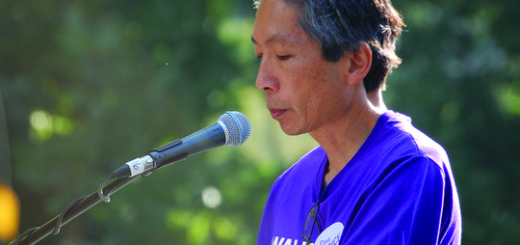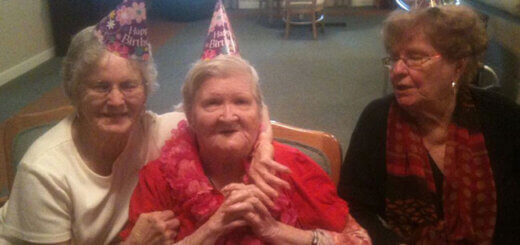Fortuna residents volunteer as a way to give back to the Alzheimer’s Association
When John Schmidt’s mother, Margie, was diagnosed with Alzheimer’s disease, he put together a team of professionals, friends and neighbors to aid him in caring for his mother. Now that she’s passed, John and his wife Terry give back to the Alzheimer’s Association® by volunteering their time on the Walk to End Alzheimer’s® committee.
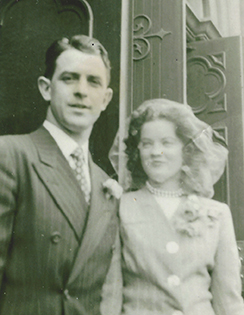
A lifetime of helping others
Margie Schmidt was one of four children born in Indiana. Despite growing up poor during the Great Depression, Margie had a great attitude towards life. She was friendly, kind and always offered to help people. She enjoyed demonstrating food in grocery stores and always had a joke to share.
After World War II, Margie met her husband at a Ryerson Steel Mill dance and then moved to California. She became a telephone operator and worked there for several years. “She received so many notes from her employer thanking her for helping customers,” said John. “She used to keep a tally sheet every time someone called and asked about a restaurant. Whichever one received the most tallies was the one we would eat at that week. We had so many wonderful experiences because of it.”
Switching roles
Because of the way she was raised, Margie was of the mindset that you didn’t want to be a burden on your family. This made it that much harder for John when she began to show signs of dementia. “Mom was living in Redding, and I was in Sacramento,” said John. “I knew she was getting older but when her apartment manager started calling me to let me know that she was doing strange things, I began to worry.”
Since her husband’s death five years prior, Margie had been living alone. Every time John would come up to visit her, she would clean up her whole house and pretended that everything was fine. However, John could see through “˜the act.’
In 2004, on her 83rd birthday, John decided it was time for his mom to move in with him. “She didn’t know she wasn’t going to be coming back to her home,” said John. “She thought she was just visiting me for her birthday. It was that day that the role reversal began. I wasn’t just her son; I was now the parent. It wasn’t too long before I took away the “˜teenager’s’ car keys.”
Building his team
“I remember getting a book that talked about Alzheimer’s,” said John. “The one thing I took away from that book was you have to put a team together to take care of your loved ones.”
John began to assemble his team. At first it was just his mother’s doctors. As he began to need more time off to care for his mother in different capacities, he realized he would also need the support of his employer. John said, “My employer was very helpful and understood my situation.”
Not alone
One of the most important parts of John’s team was his support group. “I attended a support group in Sacramento for many years,” said John. “It let me know I wasn’t alone. There are people out there with problems similar to mine. Even though everyone has a unique situation there is a commonality to what you’re having to deal with. We’re not alone. There are resources to help us.”
As the disease progressed, John knew he couldn’t continue to care for his mom on his own. He expanded his team to include his neighbors. “I had one neighbor who knew of a caregiver who was available,” said John. “Sandy was very experienced and helpful. Since she lived a short distance away she was always available to help out. I was able to continue to work because of their help.”
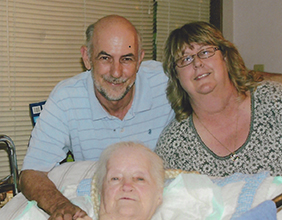
Terry joins the team
From there, John’s team grew to include his wife, Terry. “I met John when his mother was living with him,” said Terry. “I had a step grandfather that had passed away from Alzheimer’s, so I understood what John was going through. I’m a caregiver by nature and I like doing that kind of thing. I knew I could be a part of John’s support system.”
John also includes his bocce ball club as part of his team. “It can be frustrating caring for a loved one,” said John. “It’s nice to be able to step away for a while. There was always someone at the bocce ball court who would roll balls with you and listen to music. It was such a big part of my life that Terry and I had our wedding reception there.”
Becoming volunteers
In 2017, two years after his mother passed, John and Terry moved up to Fortuna, located just south of Eureka. They heard a radio ad asking for volunteers for the Walk to End Alzheimer’s. “We were very fortunate to hear the ad,” said John. “It caught my ears and we called the Alzheimer’s Association and signed up to volunteer.”
Both John and Terry signed up for the Humboldt County Walk to End Alzheimer’s committee. There are seven different subcommittees to join that include things such as: recruiting new teams, spreading the word about Walk to End Alzheimer’s and the Alzheimer’s Association, or even figuring out the day-of logistics.
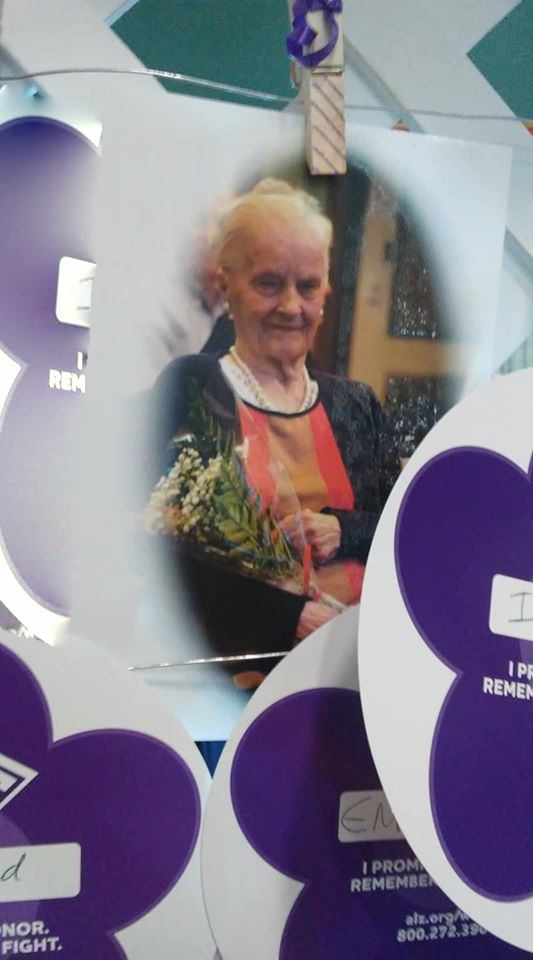
The couple joined two different sub committees that played to their individual strengths. Terry enjoys the creative aspect of helping people share their memories on Walk day. As a member of the Mission subcommittee, she helped build a memory wall to use on Walk day. “In past years I’ve helped our memory wall grow,” said Terry. “The first year we just had a few people put pictures of their loved ones who have or had the disease on the wall. The next year, we received even more pictures and we filled the whole wall.”
John’s favorite place to be is leading the logistics subcommittee. “I’m an engineer who’s detail oriented,” said John. “I enjoy figuring out the route Walkers will take and working around unexpected things, like construction zones.”
Staying busy while sheltering in place
This year’s Walk will be different. We are not coming together like we normally would. Instead we are asking people to walk in their local communities on Walk day. Because of this, Terry and John won’t be planning the route or working on a memory wall.
Instead, John is working diligently with city councils across Humboldt County to find locations to display the “˜view only’ Promise Gardens. These gardens will be filled with promise flowers to honor past and present caregivers, supporters and those living with the disease.
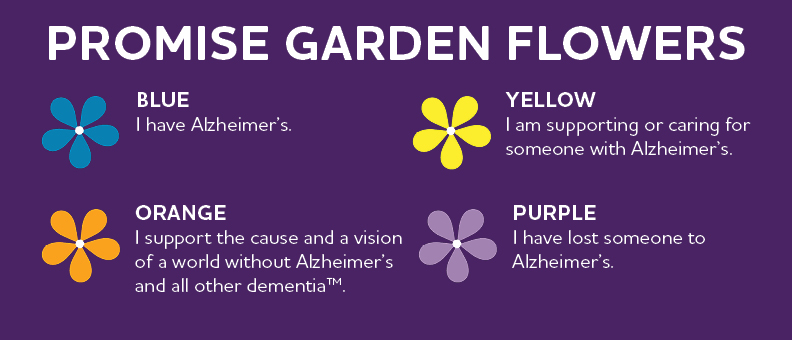
Terry, on the other hand, is spending her time finding items to put into gift baskets that will be given away at the celebration party, hosted after the Walk. “Terry makes beautiful baskets,” said Kim Coelho, Walk Manager for the Humboldt County Walk. “The committee is doing what they can, knowing that some folks and businesses are more affected by the pandemic than others.”
Encouraging others to participate
Terry and John are still relatively new to the area, but that doesn’t stop them from encouraging as many people as they can to participate in Walk. “We send letters and talk to our friends and neighbors,” said John. “It’s an evolving thing. People who can’t or don’t want to walk can always make a donation to our team.”
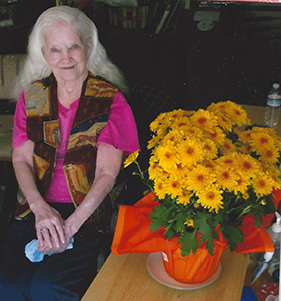
Supporting research
Terry and John want to find a cure, and they know that money raised from the Walk to End Alzheimer’s directly supports research. “In the end, I was a full-time caregiver for John’s mom,” said Terry. “I know what it’s like and I don’t want anyone to go through this. I don’t know that John won’t get Alzheimer’s.
“As a cancer survivor, I know there is a lot of money that goes into cancer research, but there isn’t a lot of money that goes into Alzheimer’s research. Passionately, I serve because I want to find a cure. Many hands make light work and I believe that the work John and I do for the Alzheimer’s Association is making a difference.”
If you’re Interested in becoming a volunteer for the Walk Committee find out more here. This year’s Walk is on every sidewalk track and trail in your hometown. Join John and Terry’s team, Margie’s Memories and walk with them on October 10, 2020 for the Humboldt County Walk to End Alzheimer’s. Not in Humboldt County? Find a Walk near you at alz.org/walk.
Learn more:






